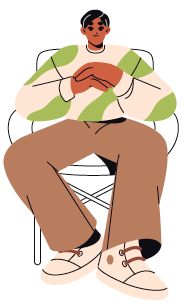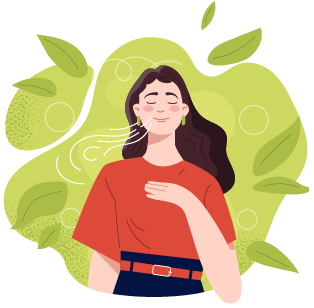Mindfulness is a practice that helps us improve awareness of our experiences in the present moment. Research has shown that practicing mindfulness can have many benefits in schools, such as reduced stress, improved relationships, and increased academic performance1. Three mindful activities that are simple to practice in the classroom include the body scan, mindfulness of breathing, and gratitude practices.
Before Getting Started
Try to ensure the classroom is calm. You can do this by turning down any lights and playing soft, calming music.
Body Scan

The Body Scan is an effective method of noticing and calming your body. This activity can help soothe nervousness such as before tests or athletic events, especially if practiced regularly2.
Instructions (can be said aloud):
- Find a comfortable seat and close your eyes if that feels good. If not, you can gently look down at the ground in front of you.
- Starting from your feet, slowly move your attention upwards through your body, checking for any tension that might be present.
- Scan the body in the following order: feet, ankles, legs, hips, belly, chest, back, shoulders, arms, hands, neck, face, and the back of your head.
- Focus on each area, take a breath and imagine sending your breath there. Let that part of your body relax like you’re giving it a little break.
- When you are done stay quiet with your eyes closed for about 60 seconds, noticing the effects of the practice on your body.
Mindfulness of Breathing

Paying attention to your breathing can help you stay in the moment by noticing the natural way your body breathes in and out. Regular practice can bring benefits such as a greater ability to focus on tasks and a greater resilience to stress3.
Instructions (can be said aloud):
- Find a comfortable seat and close your eyes if that feels good. If not, you can gently look down at the ground in front of you.
- Feel your body supported by your seat and sit up straight so that you can breathe freely.
- Pay attention to where you can feel your breath. This might be in your nose, or in the center of your chest, or in your belly.
- Try to follow one full breath from start to finish breathing in and then breathing out. If it helps you to feel the rhythm of your breath, you can place a hand on your belly to feel it rise as you breathe in and fall as you breathe out.
- Don’t try to change your breath. Just notice it as it comes in and goes out. Try to do this three times. Note: students can gradually increase the number of mindful breaths over time
- When you are done, stay quiet with eyes closed for about 60 seconds, noticing the way your body feels.
Gratitude Practices

Gratitude means noticing and appreciating the good things in your life. When you practice gratitude, it can help you feel more positive, kinder to yourself, and more caring toward others.
Instructions (can be said aloud):
- Find a comfortable seat and close your eyes if that feels good. If not, you can gently look down at the ground in front of you.
- Feel your body supported by your seat. Pay attention to any feelings that are present in your body and allow those feelings to be there. Don’t try to change them.
- Focus one good thing in your day today or generally in your life, no matter how small this thing is. Like a joke from a friend, a favorite snack you had, or a song you like.
- Continue to focus on this thing and notice how you feel in your body when you think about it.
- Come back to focus on your body supported by your seat. When you are done stay quiet with your eyes closed for about 60 seconds, noticing the way your body feels.
Other ways for students to encourage gratitude include:
- Keep a journal where you record one thing you are grateful for each day.
- When you are feeling upset, close your eyes, focus on your breath, and think of three things you are grateful for, no matter how small they are.
- Write a text message to someone who has done something you appreciated, just to say thanks.
Interested in more mental health resources for school staff? Learn more about our free resources and Notice. Talk. Act.® at School mental health training on our website: apaf.org/schools
References
- Monsillion J, Zebdi R, Romo-Desprez L. School Mindfulness-Based Interventions for Youth, and Considerations for Anxiety, Depression, and a Positive School Climate-A Systematic Literature Review. Children (Basel). 2023 May 11;10(5):861. doi: 10.3390/children10050861. PMID: 37238409; PMCID: PMC10217750.
- Stahl B, Goldstein E. A mindfulness-based stress reduction workbook. New Harbinger Publications, 2019.
- Sofer OJ, Brensilver M. The Mindful Schools Curriculum for Adolescents: Tools for Developing Awareness. New York: W.W. Norton & Company, 2019.
- Broderick PC. Learning to Breathe: A Mindfulness Curriculum for Adolescents to Cultivate Emotion Regulation, Attention, and Performance. Oakland, CA : New Harbinger Publications, 2013.
- Semple RJ, Droutman V, Reid BA. Mindfulness goes to school: things learned (so far) from research and real-world experiences. Psychol Sch. 2017 Jan;54(1):29-52. doi: 10.1002/ pits.21981. Epub 2016 Nov 30. PMID: 28458403; PMCID: PMC5405439.
- Zenner C, Herrnleben-Kurz S, Walach H. Mindfulness-based interventions in schools-a systematic review and meta-analysis. Front Psychol. 2014 Jun 30;5:603. doi: 10.3389/fpsyg.2014.00603. PMID: 25071620; PMCID: PMC4075476.
